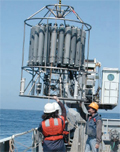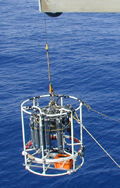mapping
Water Column
Discovering New Hydrothermal Fields: Prospecting for Plumes
Two of our goals on VISIONS ‘05 will be to characterize hydrothermal plumes formed from active chimneys at the Endeavour Segment vent fields and to explore for new fields. Because the hydrothermal fluids are warmer, less dense, and more buoyant than the surrounding cold ocean water, plumes rise in the water column above the fields, similar to those emitted from smoke stacks or cooling towers on a cold winter day. Because of their anomalous chemistries, temperatures, and (sometimes) particulate content, the hydrothermal plumes serve as valuable guides to discovering new vent fields.
Prospecting for Plumes with a CTD
During this expedition we will prospect for these plumes using an instrument package called a CTD (which stands for conductivity-temperature-and depth, parameters measured by this instrument). The instrument on the R/V Thompson is a Sea-Bird CTD (LINK TO PHOTO) system mounted on a tall, round metal frame with 24 10-liter bottles for sampling fluids in real time. The instrument will also a fluorometer and transmissometer to measure the fluorescence and amount of particles in the water. This instrument is connected to the ship by a conducting wire, which allows an electronic signal to be sent down and up from the CTD to the ship and vice versa. Data are continuously transmitted to the ship as the CTD is lowered, which allows us to measure the chemical, thermal, and particulate character of the water.
Bottles Trap Fluids
Each bottle mounted on the frame has two spring-loaded end caps that are fixed in the open position (like a hollow tube) when the instrument package goes into the water. When we see an interesting anomaly in the water column, we can electronically snap the end caps closed, trapping fluids immediately. In this way we can bring the instrument back onboard and retrieve the sampled hydrothermal plume water, which is later analyzed for its chemistry and also for its microbial content.
Off the Side of the Ship
We operate the CTD by loering it into the water from the side of the ship. It will descend on the wire to within a few meters above the seafloor. During this process we keep the ship in a stationary position, generally done under computer control. We use these vertical water casts to find detailed characteristics in the water column. CTD casts serve a dual purpose: they provide us with information about the water column and acquire a sound-velocity profile, which is important in acquiring good navigation.
Like a Needle in a Haystack
The mid-ocean ridge spreading network spans a distance of ~60,000 km. To find new sites of hydrothermal vents can sometimes be like looking for a needle in a haystack. To efficiently look for new fields we first make educated guesses on where we might expect to find them based on the geology of the area. Usually, in a new area this means that we spend a lot of time looking at bathymetric maps, which may provide hints about field locations.
Zigzagging Through the Water Column
If we are in exploration mode, looking for a new vent field, we may operate the CTD in a “tow-yo”. In this case, we lay out a survey line for the ship and instrument to follow, then lower the CTD into the water and then start driving the ship very slowly (<1 knot) along the survey line. The CTD is first lowered close to the seafloor, and then the wire is pulled in to raise the instrument 200-500 m above the seafloor. As the ship continues on its survey path this process is repeated over and over again—the CTD follows a zig-zag or saw-toothed pattern through the water column. In this manner, we can map out significant areas of the water column to search for new sites of venting.

